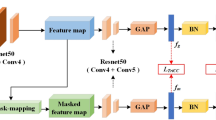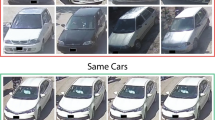Abstract
Vehicle re-identification is becoming an increasingly important problem in modern intelligent transportation systems. Substantial results have been achieved with methods based on deep metric learning. Most of the previous works tend to design complicated neural network models or utilize extra information. In this work, we introduce a simple Angular Triplet loss on the basis of analysis of different feature representations constrained by softmax loss and triplet loss. A batch normalization layer with zero bias is adopted to pass through the embedded feature before loss calculation. Then, triplet loss is calculated in cosine metric space instead of Euclidean space. In this way, triplet loss can cooperate with softmax consistently. By unifying the metric space of these two types of losses, the proposed method achieves 77.3% and 95.9% in rank-1 on VehicleID and VeRi-776 datasets, respectively. With only global features utilized, the proposed model can be seen as an effective baseline for vehicle re-identification task.







Similar content being viewed by others
References
Bai YX, Lou Y, Gao F, Wang S, Wu Y, Yu Duan L (2018) Group-sensitive triplet embedding for vehicle reidentification. IEEE Trans Multimed 20:2385–2399. https://doi.org/10.1109/TMM.2018.2796240
Bromley J, Bentz J, Bottou L, Guyon I, Lecun Y, Moore C, Sackinger E, Shah R (1993) Signature verification using a “siamese” time delay neural network. Int J Pattern Recognit Artif Intell 7(4):669–688. https://doi.org/10.1142/S0218001493000339
Chopra S, Hadsell R, LeCun Y (2005) Learning a similarity metric discriminatively, with application to face verification. In: The IEEE conference on computer vision and pattern recognition, pp 539–546. https://doi.org/10.1109/CVPR.2005.202
Chu R, Sun Y, Li Y, Liu Z, Zhang C, Wei, Y (2019) Vehicle re-identification with viewpoint-aware metric learning. In: The IEEE international conference on computer vision, pp 8282–8291. https://doi.org/10.1109/ICCV.2019.00837
Deng J, Dong W, Socher R, Li LJ, Li K, Li FF (2009) Imagenet: a large-scale hierarchical image database. In: The IEEE conference on computer vision and pattern recognition, pp 248–255. https://doi.org/10.1109/CVPR.2009.5206848
Deng J, Guo J, Xue N, Zafeiriou S (2019) Arcface additive angular margin loss for deep face recognition. In: The IEEE conference on computer vision and pattern recognition, pp 4690–4699. https://doi.org/10.1109/CVPR.2019.00482
Feng Y, Yuan Y, Lu X (2019) Person reidentification via unsupervised cross-view metric learning. IEEE Trans Cybern. https://doi.org/10.1109/TCYB.2019.2909480
He B, Li J, Zhao Y, Tian Y (2019) Part-regularized near-duplicate vehicle re-identification. In: The IEEE conference on computer vision and pattern recognition, pp 3997–4005. https://doi.org/10.1109/CVPR.2019.00412
He K, Zhang X, Ren S, Sun J (2016) Deep residual learning for image recognition. In: The IEEE conference on computer vision and pattern recognition, pp 770–778. https://doi.org/10.1109/CVPR.2016.90
Kanacı A, Zhu X, Gong S (2018) Vehicle re-identification in context. In: German conference on pattern recognition. Springer, Berlin, pp 377–390. https://doi.org/10.1007/978-3-030-12939-2_26
Kingma D, Ba J (2014) Adam: a method for stochastic optimization. In: International conference on learning representations
Kumar R, Weill E, Aghdasi F, Sriram P (2019) Vehicle re-identification: an efficient baseline using triplet embedding. In: The international joint conference on neural networks, pp 1–9. https://doi.org/10.1109/IJCNN.2019.8852059
Li Y, Li Y, Yan H, Liu J (2017) Deep joint discriminative learning for vehicle re-identification and retrieval. In: The IEEE international conference on image processing, pp 395–399. https://doi.org/10.1109/ICIP.2017.8296310
Liu H, Tian Y, Wang Y, Pang L, Huang T (2016) Deep relative distance learning: tell the difference between similar vehicles. In: The IEEE conference on computer vision and pattern recognition, pp 2167–2175. https://doi.org/10.1109/CVPR.2016.238
Liu W, Wen Y, Yu Z, Li M, Raj B, Song L (2017) Sphereface: deep hypersphere embedding for face recognition. In: The IEEE conference on computer vision and pattern recognition, pp 6738–6746. https://doi.org/10.1109/CVPR.2017.713
Liu X, Liu W, Ma H, Fu H (2016) Large-scale vehicle re-identification in urban surveillance videos. In: The IEEE international conference on multimedia and expo, pp 1–6. https://doi.org/10.1109/ICME.2016.7553002
Liu X, Liu W, Mei T, Ma H (2016) A deep learning-based approach to progressive vehicle re-identification for urban surveillance. In: European conference on computer vision, vol 9906. Springer, Berlin, pp 869–884. https://doi.org/10.1007/978-3-319-46475-6_53
Liu X, Liu W, Mei T, Ma H (2017) Provid: progressive and multimodal vehicle reidentification for large-scale urban surveillance. IEEE Trans Multimed 20:645–658. https://doi.org/10.1109/TMM.2017.2751966
Liu X, Zhang S, Huang Q, Gao W (2018) Ram: a region-aware deep model for vehicle re-identification. In: The IEEE international conference on multimedia and expo, pp 1–6. https://doi.org/10.1109/ICME.2018.8486589
Lu X, Chen Y, Li X (2017) Hierarchical recurrent neural hashing for image retrieval with hierarchical convolutional features. IEEE Trans Image Process 27(1):106–120. https://doi.org/10.1109/TIP.2017.2755766
Lv K, Du H, Hou Y, Deng W, Sheng H, Jiao J, Zheng L (2019) Vehicle re-identification with location and time stamps. In: The IEEE conference on computer vision and pattern recognition workshops
Manmatha R, Wu CY, Smola AJ, Krähenbühl P (2017) Sampling matters in deep embedding learning. In: The IEEE international conference on computer vision, pp 2859–2867. https://doi.org/10.1109/ICCV.2017.309
Movshovitz-Attias Y, Toshev A, Leung TK, Ioffe S, Singh S (2017) No fuss distance metric learning using proxies. In: The IEEE international conference on computer vision, pp 360–368. https://doi.org/10.1109/ICCV.2017.47
Oh Song H, Xiang Y, Jegelka S, Savarese S (2016) Deep metric learning via lifted structured feature embedding. In: The IEEE conference on computer vision and pattern recognition, pp 4004–4012. https://doi.org/10.1109/CVPR.2016.434
Ren J, Zhang C, Zhang L, Wang N, Feng Y (2018) Automatic measurement of traffic state parameters based on computer vision for intelligent transportation surveillance. Int J Pattern Recognit Artif Intell 32(4):1855003. https://doi.org/10.1142/S0218001418550030
Schroff F, Kalenichenko D, Philbin J (2015) Facenet: a unified embedding for face recognition and clustering. In: The IEEE conference on computer vision and pattern recognition, pp 815–823. https://doi.org/10.1109/CVPR.2015.7298682
Shen Y, Xiao T, Li H, Yi S, Wang X (2017) Learning deep neural networks for vehicle re-id with visual-spatio-temporal path proposals. In: The IEEE international conference on computer vision, pp 1900–1909. https://doi.org/10.1109/ICCV.2017.210
Sohn K (2016) Improved deep metric learning with multi-class n-pair loss objective. In: Advances in neural information processing systems, pp 1857–1865. https://doi.org/10.5555/3157096.3157304
Tang Z, Naphade M, Liu MY, Yang X, Birchfield S, Wang S, Kumar R, Anastasiu D, Hwang JN (2019) Cityflow: a city-scale benchmark for multi-target multi-camera vehicle tracking and re-identification. In: The IEEE conference on computer vision and pattern recognition, pp 8797–8806. https://doi.org/10.1109/CVPR.2019.00900
Wang H, Wang Y, Zhou Z, Ji X, Gong D, Zhou J, Li Z, Liu W (2018) Cosface: large margin cosine loss for deep face recognition. In: The IEEE conference on computer vision and pattern recognition, pp 5265–5274. https://doi.org/10.1109/CVPR.2018.00552
Wang J, Zhou F, Wen S, Liu X, Lin Y (2017) Deep metric learning with angular loss. In: The IEEE international conference on computer vision, pp 2593–2601. https://doi.org/10.1109/ICCV.2017.283
Wang Z, Tang L, Liu X, Yao Z, Yi S, Shao J, Yan J, Wang S, Li H, Wang X (2017) Orientation invariant feature embedding and spatial temporal regularization for vehicle re-identification. In: The IEEE international conference on computer vision, pp 379–387. https://doi.org/10.1109/ICCV.2017.49
Wei XS, Zhang CL, Liu L, Shen C, Wu J (2018) Coarse-to-fine: a RNN-based hierarchical attention model for vehicle re-identification. In: Asian conference on computer vision. Springer, Berlin, pp 575–591. https://doi.org/10.1007/978-3-030-20890-5_37
Yang L, Luo P, Change Loy C, Tang X (2015) A large-scale car dataset for fine-grained categorization and verification. In: The IEEE conference on computer vision and pattern recognition, pp 3973–3981. https://doi.org/10.1109/CVPR.2015.7299023
Yang L, Luo P, Loy CC, Tang X (2015) A large-scale car dataset for fine-grained categorization and verification. In: The IEEE conference on computer vision and pattern recognition, pp 3973–3981. https://doi.org/10.1109/CVPR.2015.7299023
Zhang J, Wang FY, Wang K, Lin WH, Xu X, Chen C (2011) Data-driven intelligent transportation systems: a survey. IEEE Trans Intell Transp Syst 12(4):1624–1639. https://doi.org/10.1109/TITS.2011.2158001
Zhang Y, Liu D, Zha ZJ (2017) Improving triplet-wise training of convolutional neural network for vehicle re-identification. In: The IEEE international conference on multimedia and expo, pp 1386–1391. https://doi.org/10.1109/ICME.2017.8019491
Zhou Y, Shao L (2018) Viewpoint-aware attentive multi-view inference for vehicle re-identification. In: The IEEE conference on computer vision and pattern recognition, pp 6489–6498. https://doi.org/10.1109/CVPR.2018.00679
Zhu J, Zeng H, Huang J, Liao S, Lei Z, Cai C, Zheng L (2019) Vehicle re-identification using quadruple directional deep learning features. IEEE Trans Intell Transp Syst 21:410–420. https://doi.org/10.1109/TITS.2019.2901312
Acknowledgements
This research was funded by the National Natural Science Foundation of China under Grant 61633019, the Science Foundation of Chinese Aerospace Industry under Grant JCKY2018204B053 and the Autonomous Research Project of the State Key Laboratory of Industrial Control Technology, China (Grant No. ICT1917).
Author information
Authors and Affiliations
Corresponding author
Additional information
Publisher's Note
Springer Nature remains neutral with regard to jurisdictional claims in published maps and institutional affiliations.
Rights and permissions
About this article
Cite this article
Gu, J., Jiang, W., Luo, H. et al. An efficient global representation constrained by Angular Triplet loss for vehicle re-identification. Pattern Anal Applic 24, 367–379 (2021). https://doi.org/10.1007/s10044-020-00900-w
Received:
Accepted:
Published:
Issue Date:
DOI: https://doi.org/10.1007/s10044-020-00900-w




